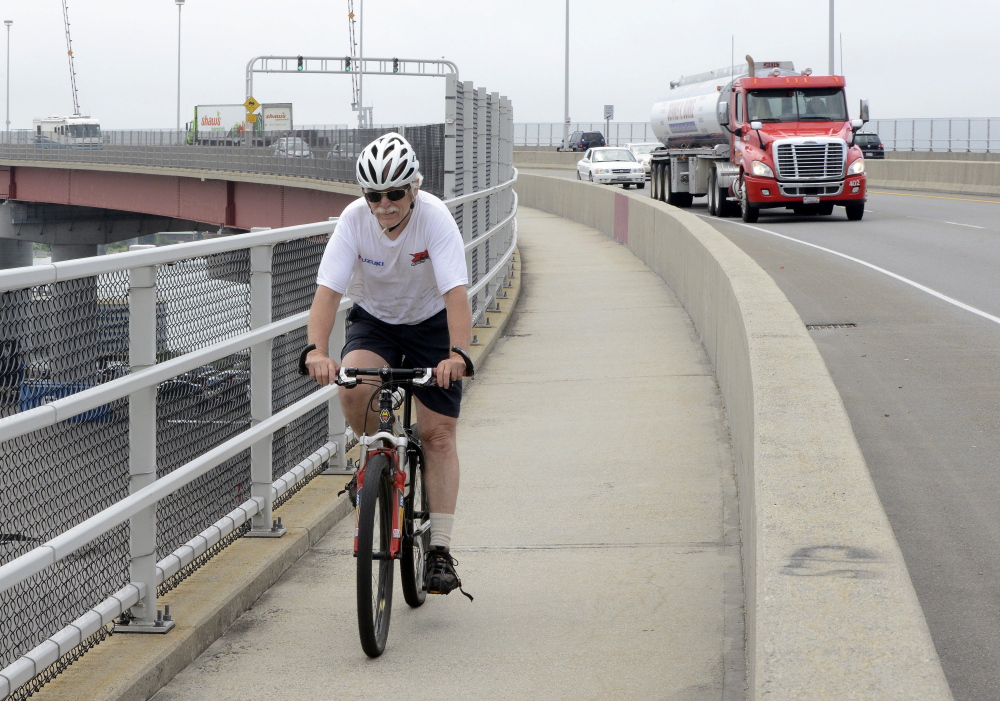Walkers and bicyclists who use the busy Casco Bay Bridge to get between Portland and South Portland can rest easy – the Maine Department of Transportation won’t shut down the entire protected sidewalk while it makes repairs.
The MDOT had announced earlier this week that it was shutting down the drawbridge’s sidewalk for three weeks while a 250-foot section of the sidewalk on the lift span is sand-blasted, primed and painted.
Originally, MDOT officials had planned to close the entire sidewalk, forcing the pedestrians and cyclists who cross the bridge daily to find alternative transportation or use the unprotected shoulder of the road next to passing cars.
But after consulting with city officials and advocacy groups, Tim Soucie, a regional traffic engineer with the MDOT, said parts of the sidewalk that aren’t being worked on will remain open.
The MDOT will now use ramps, an existing gate and a new cut in the concrete barrier between the sidewalk and the road to briefly detour pedestrians and bike traffic off the sidewalk while work is being done, Soucie said.
“After initial comments (the MDOT) received lately, we worked with partners and cities for cost-effective solutions to maintain pedestrian access,” Soucie said in a phone interview. “And we think we have a good plan.”
Bicyclists and pedestrians will still be able to access a majority of the protected sidewalk, and will be directed around the construction area. Ramps also will be created to provide access for wheelchair users that is compliant with the federal Americans with Disabilities Act.
The traffic shoulder on the bridge serves as a designated bike lane, but because of the speed of passing cars – the posted limit is 40 mph – many bicyclists use the protected sidewalk instead.
Soucie said a temporary, hard-plastic curb will be placed along the bike lane in the area where pedestrians will be walking next to the road to provide a stronger visual demarcation of the bike lane. “This will provide a clear separation between the vehicular travel lanes and bike lane for the area where pedestrians will not be walking on the sidewalk,” Soucie said.
Signs will also instruct pedestrians in both directions to keep close to the barrier.
Soucie said the detour is cost-effective and the price differential is reasonable. The cost is still being estimated.
The timeline for the project will not change, with construction scheduled to start Monday and finish Aug. 10. The full sidewalk will reopen Monday, Aug. 11.
Brian Allenby, communications director for the nonprofit Bicycle Coalition of Maine, which had suggested temporary physical barriers to protect cyclists and pedestrians, said the new proposal will provide safe bike and pedestrian access to the bridge while the necessary maintenance work is done.
“Our partners at the Maine DOT acted swiftly to rectify the issue,” Allenby said in an email statement. “We’re hopeful that this is the first of many examples of the Maine DOT putting into practice a recently adopted Complete Streets policy that takes the needs of ALL users of the road into account when planning projects.”
The Complete Streets policy is a street planning program adopted by the MDOT that aims to ensure all users of Maine’s transportation system, including bicyclists and pedestrians, have safe and efficient access to roads.
Damon Yakovleff, the chair of the Portland Bike and Pedestrian Committee, advocated for the policy.
“I hope that, by bringing attention to the shortfalls in planning for bicycles and pedestrians in this project, accommodations in future projects will be improved,” Yakovleff said. “Ultimately, the issues with the Casco Bay Bridge sidewalk may have been a positive development.”
Yakovleff said he hopes the change in the original construction plan causes the MDOT to move quickly to fully implement the Complete Streets policy.
“This may have just been an oversight. I don’t think it was a deliberate cost-cutting measure,” Yakovleff said. “I hope this is a teachable moment.”
Send questions/comments to the editors.



Success. Please wait for the page to reload. If the page does not reload within 5 seconds, please refresh the page.
Enter your email and password to access comments.
Hi, to comment on stories you must . This profile is in addition to your subscription and website login.
Already have a commenting profile? .
Invalid username/password.
Please check your email to confirm and complete your registration.
Only subscribers are eligible to post comments. Please subscribe or login first for digital access. Here’s why.
Use the form below to reset your password. When you've submitted your account email, we will send an email with a reset code.